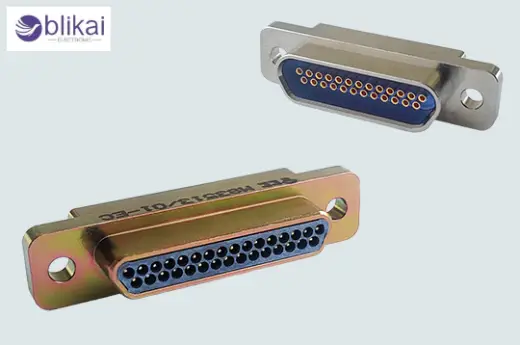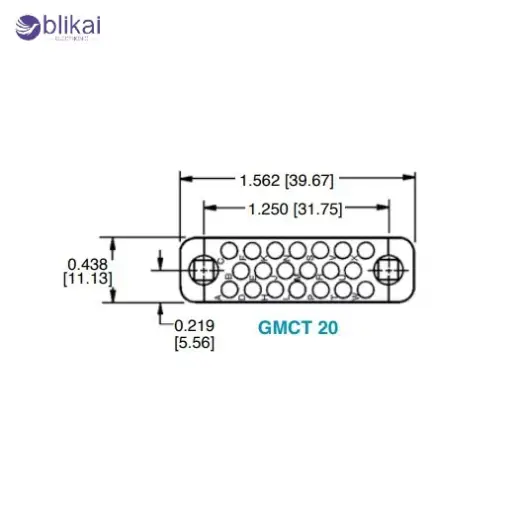Rectangular Connector: Types, Pinout, Applications & Guide
Introduction to Rectangular Connectors
One of the most commonly used solutions in interconnection in the electronics and electrical systems is the rectangular connectors. These connectors are used to provide a safe and systematic way of connecting power, signal and data lines between devices. They are rectangular in shape and can be compactly laid out with a high density of pins, and can be configured in flexible modes. Recent rectangular connectors are frequently used when space efficiency and multi-pin arrangements are important, unlike circular connectors. Rectangular connectors are used in consumer electronics as well as in industrial automation, and are important in promoting a good, reliable electrical operation.

Structure and Design Features
Rectangular connectors (object) are designed so that their housing is flat and in the shape of a rectangle with several contact pins or sockets. Additional durability may be achieved by housings made of plastic, thermoset resin or metal. Pins may be installed either in a single row, in a couple of rows or in many rows based on the needs of the application. A large number of models have locking mechanisms in the form of clips, screws, or latches to avoid disconnection due to accidents. The other important design factor is environmental resistance. There are also sealed connectors, which have IP ratings and are resistant to dust, moisture and vibration. Their general construction is what makes them fit applications that need not only to be compact but also strong.
Types of Rectangular Connectors
The rectangular connectors come in a variety of types that are optimized to perform different functions. General-purpose connectors. Standard rectangular connectors are commonly used in consumer electronics. Higher-density versions enable a greater number of pins in a small area, which is appropriate in computer and communication devices. Power rectangular connectors are intended to be used with high current and high voltage, hence they can be used in the automotive or industrial world. Signal and data rectangular connectors are used to maximize the speed of data transmission in networking and telecommunications. Professional equipment typically makes use of modular connectors that can be configured with the required number of pins. The difference between the industrial and the consumer grade models is their durability, level of insulation and ability to endure the harsh conditions.
Rectangular Connector Pinout Explained
Pinout is another thing that needs to be understood when dealing with rectangular connectors. The pinout determines the structure and purpose of every pin at the connector. The pins are usually numbered in series within rows by the manufacturer, beginning at one corner. In a standard configuration, the power supply is isolated on some pins, ground on others and signal transmission on the others. Proper pinout mapping guarantees a safe operation and the elimination of short circuits or malfunctions. In the case of engineers, it is important to read datasheets and wiring guides prior to installation. Connecting a rectangular connector improperly may damage equipment, so pinout knowledge is a primary concern with connector usage.

Electrical Specifications and Ratings
Each of the rectangular connectors has a specific electrical parameter rating. The ratings of voltages and currents determine the maximum power that the connector is capable of safely carrying. Contact resistance dictates the efficiency of current flowing through the connection; the lower the resistance, the more stable the operation. Other important specifications include insulation resistance, which, in this case, guarantees that no current passes between adjacent pins. Temperature ratings characterise the safe operating temperature of the connector, usually between -40 °C and more than 100 °C, by the type of material used. Other connectors also have electromagnetic shielding, which is necessary in data communications or delicate electronics. These ratings enable engineers to make the correct decisions regarding connector usage.
Applications of Rectangular Connectors
Industrial Automation and Robotics
Rectangular connectors in the automation of industrial processes connect sensors, actuators, Programmable Logic Controllers and motor drives. The rugged cases and locking capabilities of their housings guarantee their stability in the vibration-and electrical-noise-prone environments. Compact high-density connections, advantageous to servomotors and control systems, are also a benefit of robotics.
Computers and Consumer Electronics
The laptops, servers and game consoles, as well as appliances, often use a rectangular connector. They are used to offer high pin density in intra-module internal connections, like processors and displays. They are best suited to mass-produced electronics because of their easy installation and dependable performance.
Automotive and Transportation Systems
Contemporary automobiles use rectangular connections of the engine control unit, infotainment, light, and ADS. Their locking and vibration resistance is secure and makes them highly reliable in the long run. In electric cars, they are used to interface battery packs and power systems, and in control and signalling apparatus in buses and trains.
Aerospace and Defense Electronics
The aerospace and defense industries require shock, vibration and high-temperature-resistant connectors. Avionics, communication, navigation and radar use rectangular connectors. They have a high EMI resistance and meet stringent standards that render them appropriate for mission-critical equipment.
Medical Equipment and Instrumentation
Rectangular connectors are used in medical equipment like patient monitors, MRI and lab equipment to make compact and reliable connections. Their quality is that they last longer in usage when used regularly, and the medical-grade versions are highly insulated and safe in healthcare settings.
Installation and Wiring Guide
Setting up a rectangular connector involves taking care and having exactness in the wiring. The initial one is determining the right pinout through the datasheet. Connection can then be made by crimping or soldering after the wires have been stripped to the necessary length. Crimping is quicker and more desirable in mass production, and soldering has excellent connections in custom-made designs. After the contacts are attached, they are then inserted into the connector housing until they are locked. One should not make a typical mistake like over-stripping of wires, not aligning the pins, or working with poor tools. Safety measures such as power off and use of insulated tools should always be taken when installing.
Advantages of Rectangular Connectors
Rectangular connectors have some advantages over other connector types. They have high pin density, which enables them to connect several times in a small area, thus decreasing the circuit board. They are simple to set up and support, courtesy of modular housing models. Another strength is versatility, as it will be able to work with power and data connections. Locking mechanisms are used to improve mechanical stability, which keeps the connection free of vibration or shock. Also, there are numerous rectangular connectors, which undergo repeated mating cycles, making them reliable over time. Their compact design, stability and performance have made them a necessity in any industry.
Choosing the Right Rectangular Connector
When determining the rectangular connector to use, there are several factors that need to be considered. To begin with, there are the electrical specifications, such as current and voltage ratings. The second step is to analyze the environmental conditions, like dust, moisture, or temperature extremes; IP-rated connector sealing can be required. Layout and pin count also need to be adjusted to the requirements of the system. Shielding and impedance issues ought to be checked when high-speed data applications are to be used. Checking of industry certifications is also pertinent, particularly in automotive, aerospace or medical, where compliance is required. Appropriate connector selection promotes system safety, performance and long-term reliability.
Maintenance, Troubleshooting, and Common Issues
Rectangular connectors, just like any other component of electricity, need routine maintenance. Regular checkups will assist in the detection of worn-out contacts, loose linkages, or corrosion. Conductivity can be regained by cleaning the pins using the right solvents. Damages/Bent pins: This is a common problem that can be fixed or changed depending on the degree of damage. Vibration or repeatedly using it may create loose connections; it may be necessary to tighten or replace the connector. Another issue that may cause contact damage is misalignment during mating. A systematic procedure of troubleshooting will help ensure that the connectors will be reliable in providing connectivity without any sudden shutdown.
Future Trends in Rectangular Connectors
Electronics and connectivity are the factors defining the future of rectangular connectors. Another significant trend is miniaturization, where smaller connectors are used to provide increased pin density in small devices. Another area of interest is high-speed data transmission, where faster communication is required in 5G, cloud computing, and IoT systems. Connectors with in-built sensors or monitoring capabilities are emerging as smart to enhance safety and predictive maintenance. There is also the development of eco-friendly designs with recyclable materials and lead-free contacts. These trends outline the transformation of rectangular connectors to suit the realities of modern-day electronics.
Conclusion
Rectangular connectors are one of the foundations of the electrical and electronic systems today. They are one of the most versatile connector types because they can deal with power transmission, signal transmission, and data transmission in a wide range of industries. They are still needed by engineers and technicians alike with multiple designs, powerful features, and great reliability. It is important to comprehend the types, pinouts, specifications, and applications of their use in order to use them safely and efficiently. With technological progress, the rectangular connectors do not get outdated so that they will remain applicable in future generations. Anyone engaged in electronics knows the connectors are worth the long-term investment to learn to master them.
Some images are sourced online. Please contact us for removal if any copyright concerns arise.
How to Replace a Broken 9V Battery Connector
Choose the Right Electrical Connector Types: A Simple Guide
Fiber Optic Connectors: Types, Functions & Applications Explained
FPC Connectors: Types, Features & Applications in Electronics
Flexible Flat Cable(FFC) Connector Guide: Types, Specs & Applications
FFC vs FPC Connector: Key Differences, Types & Applications Guide
How Wire Connectors Work? A Complete Guide
What Is a Circular Connector? Features, Advantages & Applications
Barrel Connector Applications in Power Supplies and Electronics
D Sub Connector Pinout Guide: Wiring & Technical Specs










